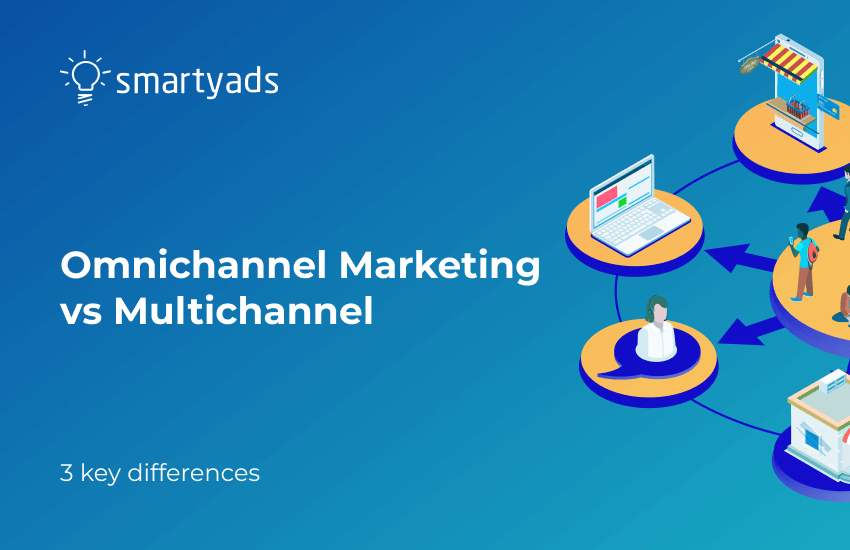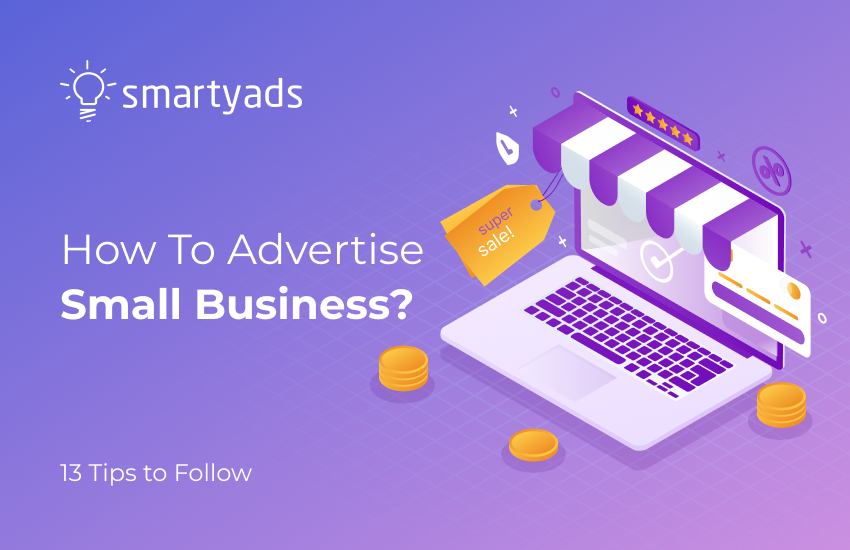When shopping online, 70% of customers use two or more channels to learn about the product they need. These touchpoints usually include brands' official websites, social networks, mobile apps, printed advertising, radio, TV, etc.
This reality obliges businesses to develop and implement multi- or omnichannel marketing strategies, which are often perceived as the same methods. However, despite a lot of similarities, they aren't equal to each other.
To clarify the distinctions, we'll thoroughly examine both strategies and share some tips on how to choose between these options so that there is now omnichannel vs multichannel dilemma for you.
What's the difference between multichannel and omnichannel marketing?
The key difference between omnichannel and multichannel approaches is that the first focuses on unifying customer experience across channels, whereas the second one basically broadens the number of channels through which the product can be promoted.
Omnichannel vs. multichannel: the basics
Both omnichannel and multichannel ways of promotion involve the use of multiple channels, such as email, SMS, social networks, websites, and others. Nonetheless, the key difference lies in how exactly a company provides and manages customer experience.
Omnichannel marketing embodies an integrated approach where a business builds its own ecosystem and ensures a uniform experience across all the selected touchpoints. As a result, customers get identical "impression" regardless of what channel they are interacting with at the moment.
Multichannel marketing focuses on products, so every channel is addressed independently. Clients may have different preferences regarding how to engage with a brand, and this approach enables companies to fulfill the unique expectations of every individual.
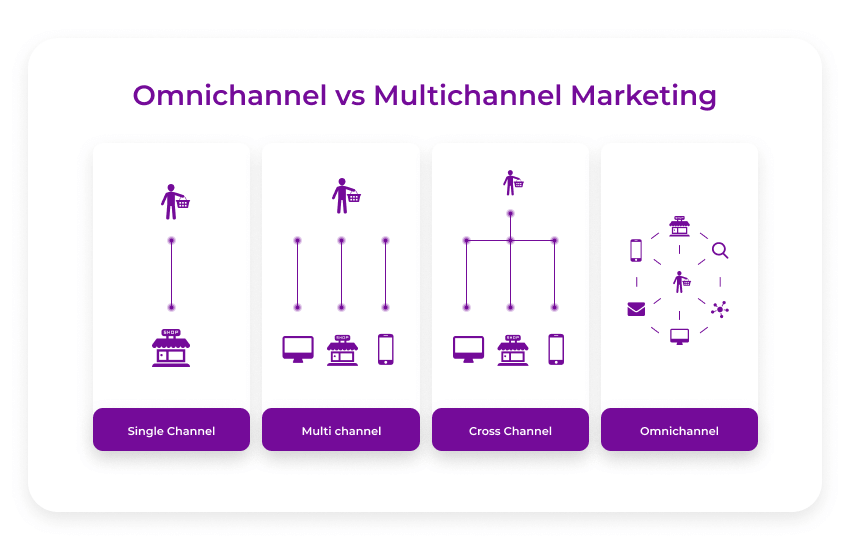
Principles of work and benefits
Now that the basics are clarified, let's review how these strategies work in detail and examine the associated benefits and challenges.
Omnichannel strategy
In essence, omnichannel marketing equates to consistent experience, which allows for meeting customer expectations more effectively. No matter how and when customers interact with a company — they should get the same message, branding, and level of service.
This involves following the same tone of voice, creating visuals in the same style, and ensuring a smooth transition between different touchpoints.
For instance, if clients can purchase products both on the website and via the app, the selection and the provided information must be the same, along with payment methods.
Here is an example: Starbucks created iOS and Android apps, and according to their omnichannel approach, they are designed in the same style as the website. Moreover, drinks and food can be ordered ahead and then picked up at a participating coffee shop.
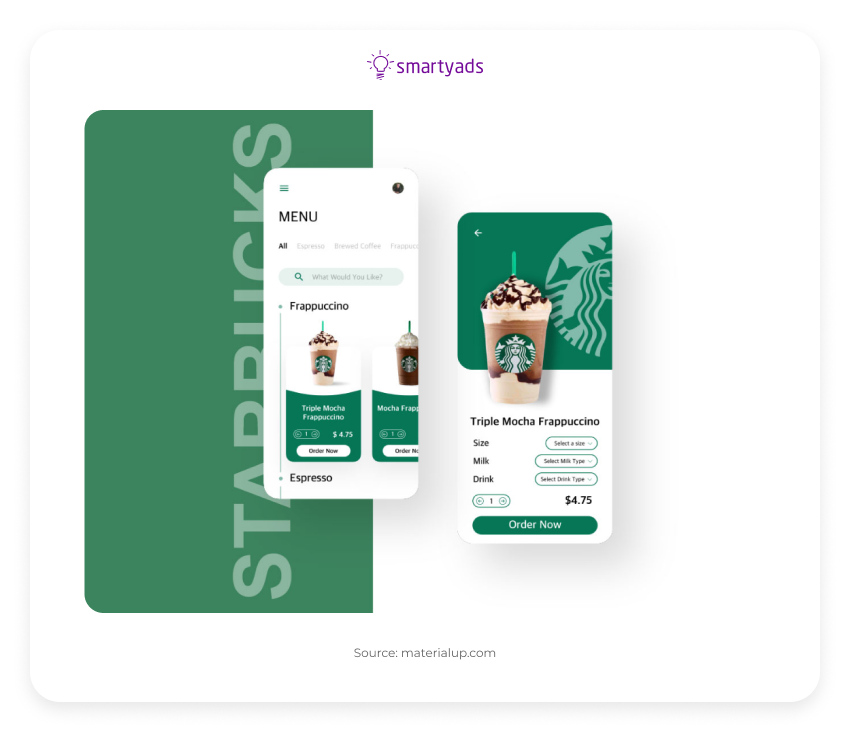
This guarantees a consistent customer experience and convenience for application users. They can order a cup of coffee from anywhere: in the physical store, on the go, or even while still being at home.
Benefits
The goal of the omnichannel approach is to deliver the ultimate experience, meet customer expectations, and, as a result, achieve better customer engagement, loyalty, and customer retention.
The main advantages are as follows:
- improved brand recognition;
- higher loyalty;
- increased customer retention rate;
- better customer experience;
- sales growth.
Challenges
As for the challenges related to omnichannel marketing, it can be complicated and costly for organizations to ensure consistency across separate channels concurrently — this requires a thorough approach.
Ahead of starting developing your strategy, check if your organization has a sufficient amount of resources. For instance, you may need to hire a designer to create visuals in the same style instead of cooperating with freelancers.
Multichannel strategy
In turn, multichannel focuses on developing a specific strategy for every marketing channel. This includes preparing separate buyer persona profiles, tailoring the messages for each of them, etc. The marketing materials can differ significantly.
Here are several examples:
- You follow a relatively informal tone on Twitter (even with some jokes) but write only professional posts for LinkedIn;
- Your ads on Instagram are designed in a completely different style from your promotional emails;
- You promote your special offers and discounts only on your website and new products — exclusively via Facebook;
- Your website and app offer different assortments of products;
- While your website provides full product information and reviews, in the app, users can find only basic details.
Benefits
A multichannel marketing strategy may seem less effective than an omnichannel because every touchpoint functions separately. However, it serves a different purpose — extending messaging reach across a greater number of marketing channels.
Here are the key benefits:
- freedom of choice for clients as they can choose their preferred channel;
- enhanced reach;
- more effective targeting;
- increased brand awareness;
- flexibility.
Challenges
At the same time, managing multiple channels separately at once requires more marketing efforts than when focusing on a unified ecosystem.
Depending on the choice of channels, you may also need to make significant investments, which can be an important factor for startups (even though omnichannel marketing is often more expensive).
4 key differences to keep in mind
So, omnichannel vs multichannel battle continues; let's see the differences between those.
Omnichannel marketing focuses on customers, and the multichannel approach prioritizes products. This may seem straightforward and obvious, but this distinction is only the tip of the iceberg.
Customer experience
In omnichannel approach, clients switch between multiple channels, and their journeys continue seamlessly due to cohesiveness. This ensures a better experience and, as a result, improved customer engagement and sales growth.
As for the multichannel method, it is slightly unpredictable. If you identify the right marketing touchpoints and cater to the needs of every buyer persona profile effectively, there might be no need for your customers to move from channel to channel.
For instance, they may only browse your website without exploring your profiles on social media. However, if they decide to interact with your brand through various channels, the key differences between them may reduce the quality of the customer journey.
Support service
When it comes to ensuring positive customer experiences, the support service plays a crucial role. An omnichannel marketing strategy implies a unified ecosystem that guarantees cross-platform communication.
Another benefit is that customers receive personalized experiences according to their data — this helps to improve customer relationships.
With a multichannel approach, ensuring personalization can be challenging due to the lack of data-driven insights. Customer experiences often vary across different channels, and it may also be complicated for clients to switch between multiple support options.
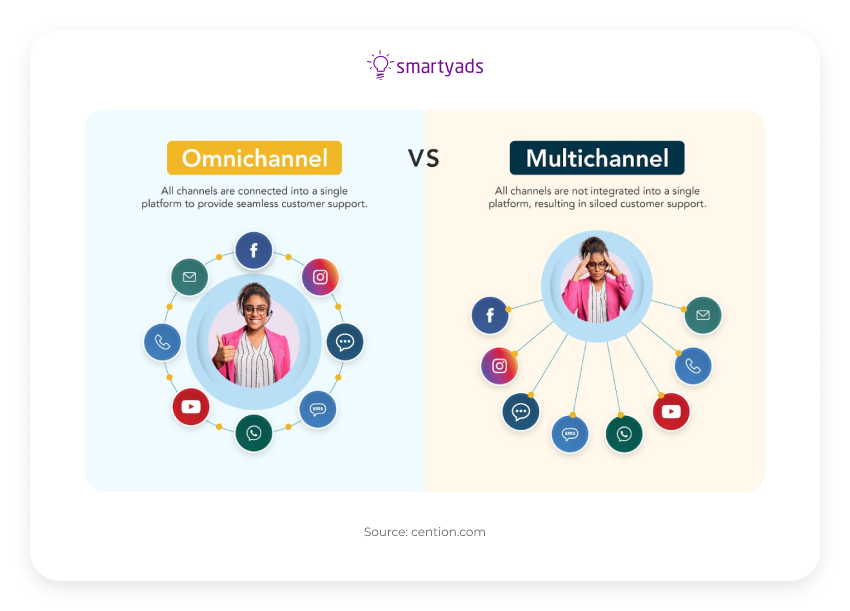
Essential effort
Developing both multi- and omnichannel strategies requires deciding on the goals, identifying buyer personas and channels, creating and distributing relevant content, etc.
Nonetheless, since multichannel approach entails working on every channel separately, it requires more effort to prepare and distribute content, analyze the performance of marketing campaigns, etc.
For instance, in multichannel marketing, you must collect customer data from every channel independently and modify every strategy according to the analysis results.
And in omnichannel, data gathered from one touchpoint can be universally used to elevate the experience across all the remaining channels.
To conclude here, the omnichannel strategy is easier and faster to refine. At the same time, they are less flexible since the selected marketing channels cannot be managed separately.
Brand recognition
Nowadays, the competition is severe, so being memorable is important for brands. Implementing an omnichannel strategy is a way to reach this goal. By improving brand recognition, you build trust and gain a competitive advantage.
Customers will be more likely to prefer you over your rivals if they have seen your brand somewhere on the Internet, and not only.
Regarding multichannel marketing, a brand's message and content can vary significantly across different channels, which can affect brand recognition.
For example, if you have different profile photos and descriptions on Instagram and Facebook, it can be hard for Instagram users to recognize you on Facebook, and vice versa.
Omnichannel vs. multichannel marketing: when to use each?
So, which marketing strategy is better? This is a question you can answer only on your own since the choice depends on your business objectives and the specificity of your audience's customer journey. It is also important to consider the current state of your business.
The first thing to do is to identify the goals. For instance, if you need to make your brand easy to recognize, omnichannel marketing is the way to go. And if you want to extend reach, multichannel would be a more effective solution.
Then, gather data about your audience (along with customer feedback) and analyze the available resources. On the basis of the collected insights, you will be able to make a data-driven decision relevant to your specific brand.
When to choose omnichannel?
Omnichannel marketing strategy can be very effective under the following circumstances:
- Your company already exists in a digital environment. It will be easier for you to enhance online presence, as you already have something to start from;
- You have enough resources. Omnichannel marketing can be costly and time-consuming. This doesn't mean that multichannel is cheap, but it's usually less demanding;
- You have enough data about your audience to analyze. If your company has just entered the market and you don't have enough data yet, it can be challenging for you to adopt a customer-centric approach from the outset.
When to say yes to multichannel?
As for multichannel marketing, here are a few situations when it can work perfectly:
- You own only a brick-and-mortar store or lack resources. The modern world requires businesses to build digital presence. However, some companies still exist only as physical retail stores. For them, going omnichannel right from the start can require too much money;
- You aim for flexibility. Since every channel works on its own, your strategy will be more flexible. It will be easier for you to adapt it to the changeable requirements and conditions;
- Your audience is very broad. If your customers have assorted preferences in terms of interaction, multichannel strategies will help you cater to their needs.
Omnichannel and multichannel retail
Omnichannel retail is booming in 2023. Marketing teams in the retail sector have come to a clear realization that throughout the customer journey, people use more than one channel. At the same time, those channels can be very different, so there's a growing need for omnichannel retail experiences.
As the economic situation turns even more uncertain, over 90% of shoppers in 2023 are noticing that prices are increasing. With this, inflation affected the purchasing decisions of 84% of questioned shoppers.
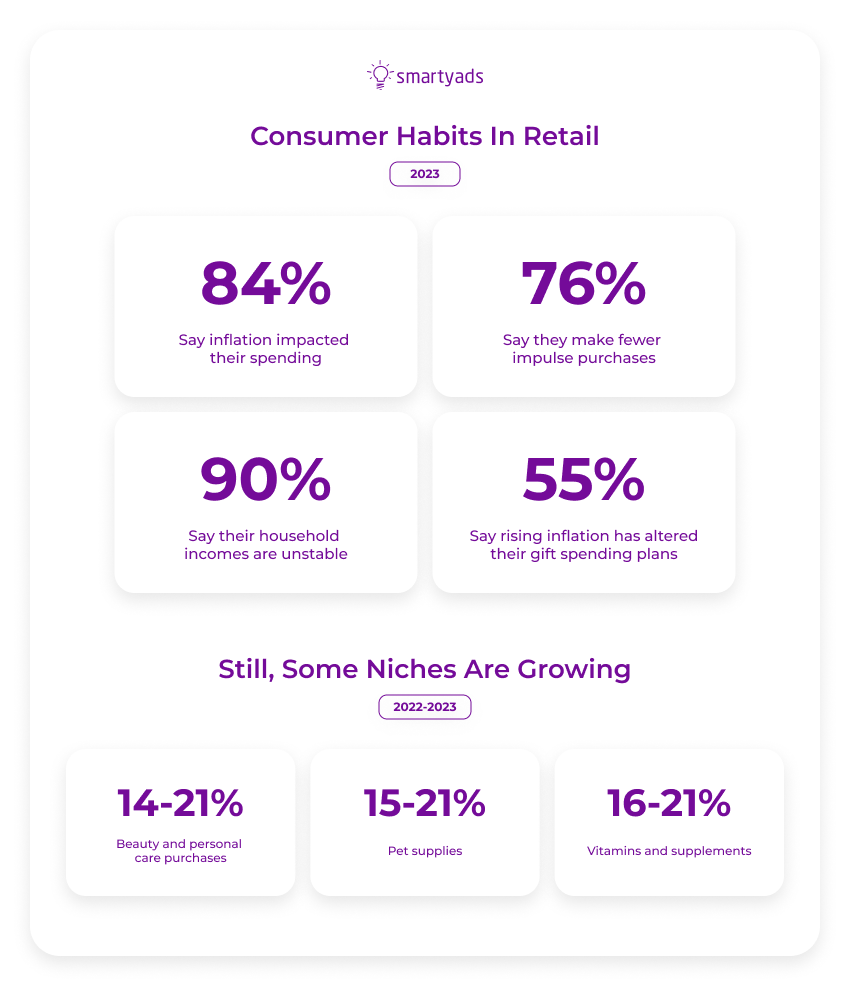
In such realms, to keep audiences engaged, brands normally use 3 or more channels to reach customers.
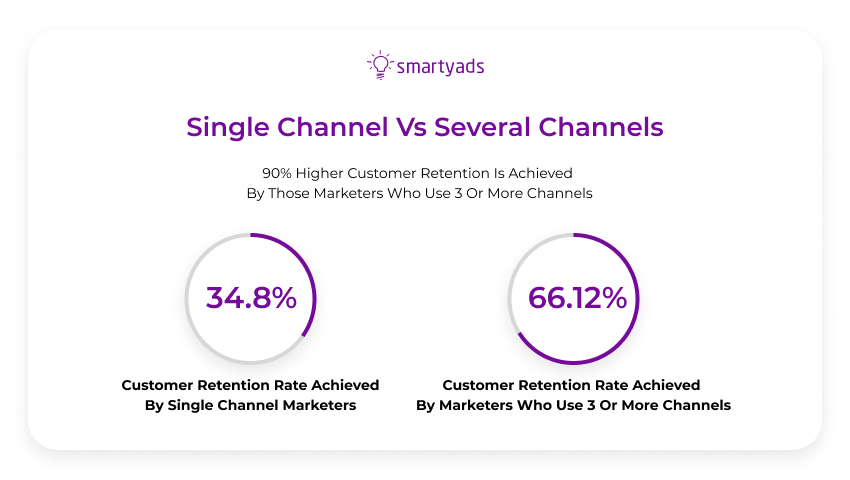
How to select multiple marketing channels?
Both omni- and multichannel methods require you to choose more than one channel for marketing. This choice must be data-driven; otherwise, reaching your goals can take more time than you expect.
The selected channels should reflect your business goals. For instance, if you want to drive customer engagement, using social media will be very helpful, as you will be able to interact with them there, share user-generated content, publish catchy posts, and so on.
After you identify the objectives, the next steps are as follows:
First of all, you need to learn more about your target audience. What social networks do they use? What forums and other third-party platforms do they visit? How do they prefer to communicate with businesses? What content types are their favorite? To collect qualitative data, consider preparing short surveys for your clients.
Then, identify your advertising budget. The more channels you select, the more you will have to pay, and some channels can be much more expensive than others. After you decide how much money you can allocate, you will be able to narrow the selection down when necessary.
It's also important to analyze your competitors. Their preferred channels can give you a hint. Note that you don't have to analyze all of your rivals — focus on the strongest ones. This tactic will be especially helpful if you don't have a large customer base to analyze yet.
When you make a final decision and start bringing your marketing strategy to life, analyze the performance of the selected channels and continuously collect relevant data. This will help you refine the strategy.
How to guarantee consistency across multiple channels?
Since omnichannel marketing entails delivering consistent experience and customer support across different channels, here are several important things for you to keep in mind:
- Build a uniform system of interconnected channels. This is a must regardless of the number of touchpoints;
- Follow the same tone of voice and design style in all your promotional materials (blog posts, videos, social media posts, emails, etc.);
- Make sure that your content looks great on any type of screen;
- Create a unified database of your customers and their preferences, and keep it up to date;
- Offer the same variety of products across all the channels. The product information should be the same on any platform, as well as pricing;
- Add an extensive selection of payment methods to every sales channels (it should be the same on any platform);
- If you offer loyalty cards or any other benefits, make sure that customers can access and use them on any channel.
Programmatic as an omnichannel boost for businesses
Omnichannel marketing requires a lot of effort: preparing creative materials, distributing them via the right touchpoints and to the right types of customers, maintaining consistency, etc.
However, with programmatic advertising platforms, you acquire and retain customers more easily. As soon as you define customer preferences and characteristics, you get a robust portrait of your audience, which can then be effectively used to raise brand awareness, conversion rate, and sales.
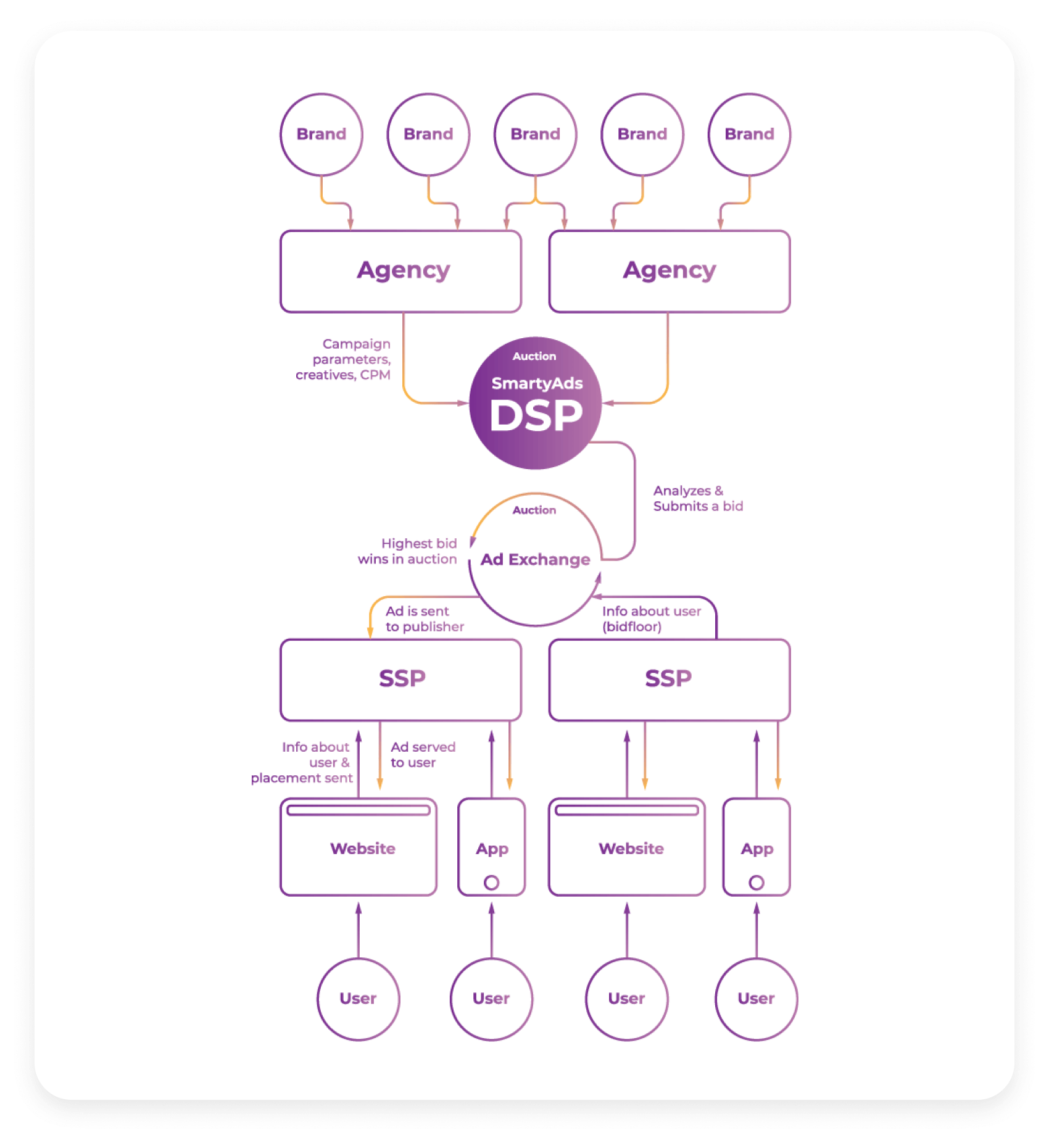
As you can see from the picture above, programmatic is an automated system where advertisers can channel ads in a smart way while utilizing AI and ML algorithms.
Based on the chosen targeting options, the system defines how relevant a particular impression can be to the user, and only then it sends the ad to the relevant viewer.
Read more about what programmatic is and how it works.
Finally, some programmatic platforms like SmartyAds DSP are working exactly on an omnichannel basis, meaning that ads can be delivered to the users on desktop, mobile, in apps, CTV, audio environment, and DOOH (digital out of home) devices.
What's even more amazing with this platform is that it will be able to automatically resize your banner ad creatives to ensure that they fit all types of screens. This feature of SmartyAds DSP is called creative autoresize, so enable it if you use banners and strive to get better reach with your ads.
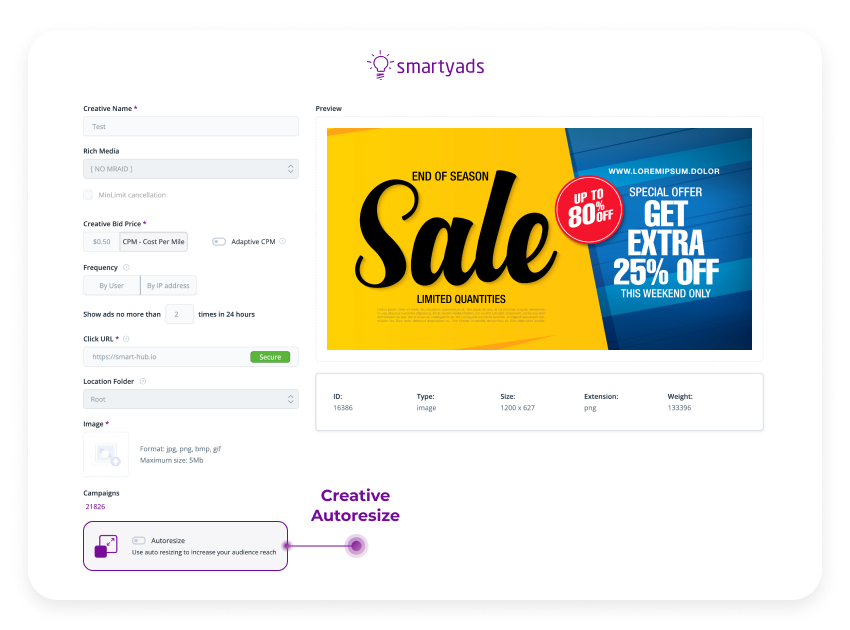
In case you don't have designers on your team who'd develop creatives with a taste and as quickly as possible, SmartyAds has some great news for you.
Recently, we've partnered with a creative agency Jam, and this means that every advertiser who needs a creative development service can contact us, and we'll organize cooperation with our partners at an affordable cost.
To sum up
To keep their place in the sun, businesses often have to decide between omnichannel vs multichannel approaches.
Each of these strategies carries a specific set of strengths and weaknesses that sales and marketing teams should be aware of. Implementing omnichannel marketing and integrating multiple channels can lead to major improvements in customer experience and increased loyalty.
On the other hand, this approach can be rather expensive and time-consuming (utilizing programmatic advertising platforms is a way to simplify the process).
Multichannel marketing is a way to expand reach, and adopting this strategy requires less investment. Although, the brand identity and customer experience can be affected.
As the digital landscape keeps evolving and customers are getting increasingly demanding, businesses need to recognize the importance of cohesive experience. Therefore, if you choose multichannel marketing at the moment, consider switching to omnichannel in the future.
Simplify and boost your marketing with an omnichannel advertising DSP platform. Register now!
